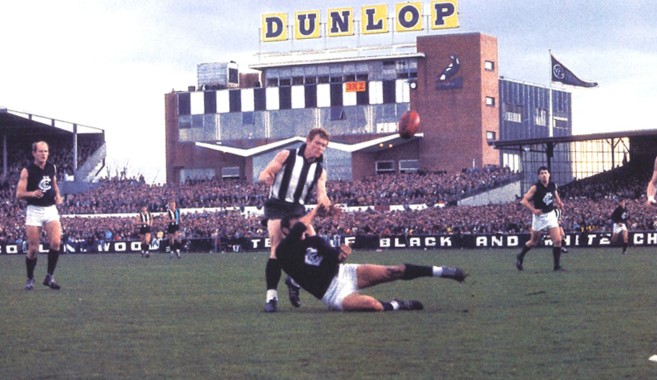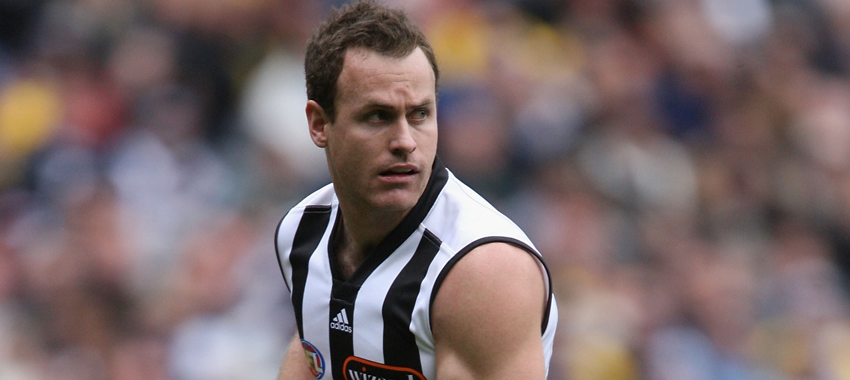Britannia is considered to be something of a precursor to the Collingwood Football Club, for it was a team that was based out of the suburb and was the first recognised team to play out of Victoria Park. The fact that it did not properly represent the suburb was a key factor that led to its eventual demise.
According to Richard Stremski, Collingwood historian and author of Kill for Collingwood (1986), the Britannia Football Club was founded in 1877 at the Crown and Anchor Hotel in Collingwood by James Cohn and P.H. Cherry. They wore blue, red and white and played its first games in 1878. It played out of Victoria Park from 1882, having played its earliest matches at the Willow Flat and Richmond Paddock.
Over time, Britannia gradually assumed control of Victoria Park during the winter, charging for admission to the ground on match day. It was sometimes forced to move its matches elsewhere when the ground became waterlogged.
Its early years were patchy before it began to consolidate in 1881. The club lost only two of its 16 games (played in a competition outside of the VFA), and its membership base grew. Politicians and businessmen began to join the club, and with continued on field improvement (highlighted by its runners up finish in the Victorian Junior Football Association in 1884), the club approached the VFA for admission into the state’s premier competition.
Unfortunately for Britannia, the club was deemed too disorganised to be included in the VFA, despite their renowned care for injured players which Stremski (1986) saw as a precursor to Collingwood’s “discipline and paternalism”.
The social struggles experienced by the suburb of Collingwood hampered Britannia’s bid to reach the VFA. This was compounded by the VFA’s decision to limit the league to 12 clubs.
Although Britannia produced some consistent results over the course of its final year, the people of Collingwood wanted change. More concisely, they wanted a club of their own. They argued that Britannia did not properly represent their suburb. What’s more, Britannia had strong connections with the Fitzroy Football Club who represented Collingwood’s closest neighbour, one with whom they did not share a cordial relationship.
In 1889, several Collingwood residents met in June 1889 at Mrs Harriet Pryde’s City Hotel in Johnston Street to form the Collingwood Football Club. With the involvement of Britannia patrons and parliamentarians William Beazley and George Landridge, a decision was then made to form a joint application for a Collingwood-Britannia team to be admitted to the VFA.
The VFA denied the joint application on the basis that Britannia was thought to be “too disorganised and amateurish” for its competition and while Britannia was content to accept the decision, the people of Collingwood would not.
Two more years of discussions and stand offs ensued between parties from both sides. Support for a Collingwood team in its own right hinged on several factors, including the VFA’s refusal to demote weaker teams from the competition.
A potential upgrade of Victoria Park became an important factor in the fate of the two sides. There was no objection from the VFA to a proposal that would have seen Britannia admitted as a Collingwood team if Victoria Park was upgraded.
The result of the struggle to form a VFA club that was truly representative of Collingwood was Britannia’s dissolution following a meeting at the Grace Darling Hotel in early 1892. Britannia’s treasurer, committeemen and the majority of Britannia’s declared their allegiances to Fitzroy in favour of backing the uncertain future of the soon to be formed Collingwood Football Club.
As Stremski (1986) notes on page 11 of Kill for Collingwood:
“Although Britannia’s role as a precursor of the Collingwood Football Club is tarnished, those Brits (Britannia supporters) who wanted to end the subordinate relationship with Fitzroy and establish Collingwood’s own senior football club had triumphed”.
One historical aside of note is the fate of Britannia’s game bell. Britannia personnel took the bell when the club shifted its allegiance to Fitzroy. It took until the 1960s before the bell was returned to Victoria Park.







